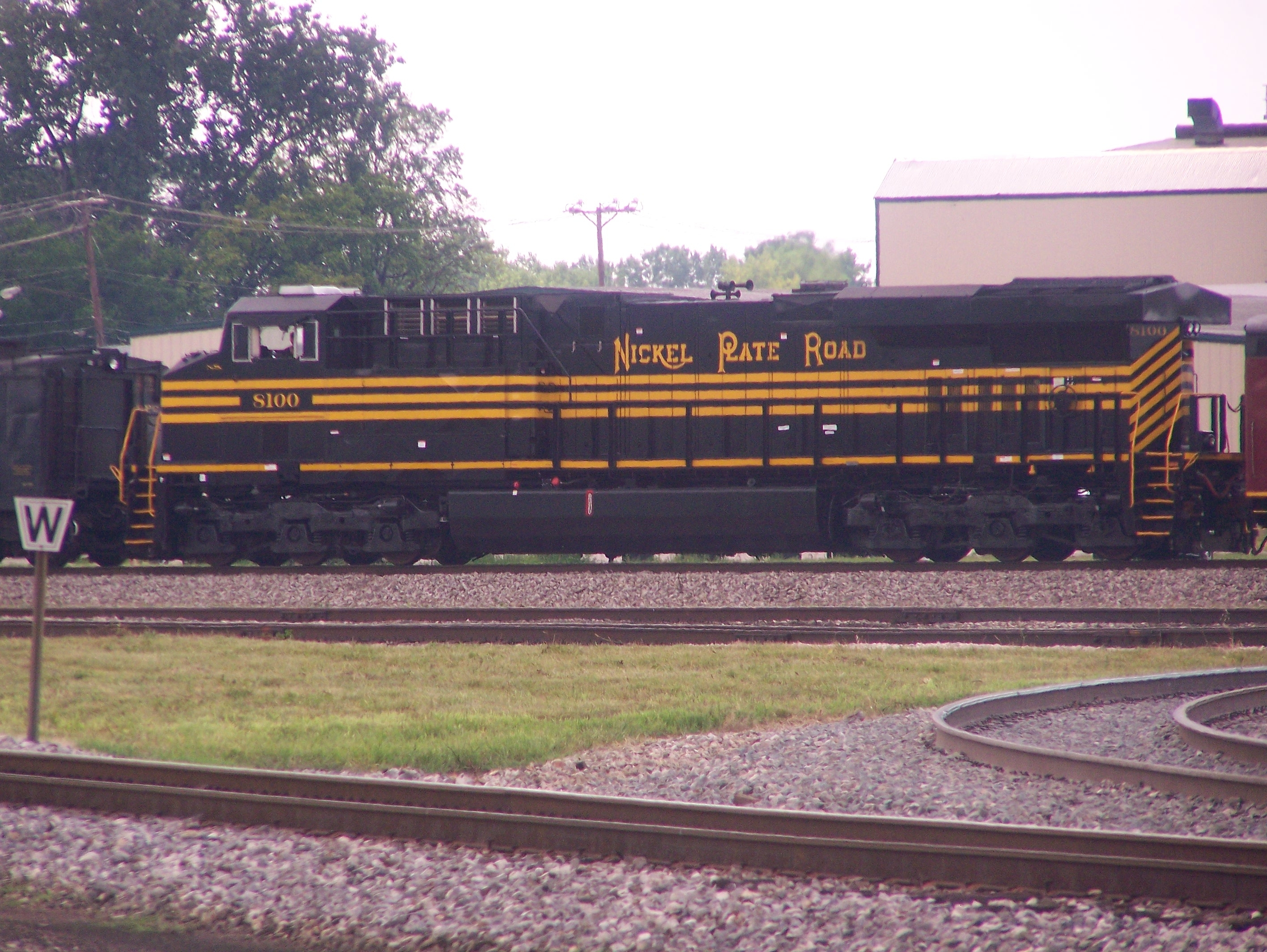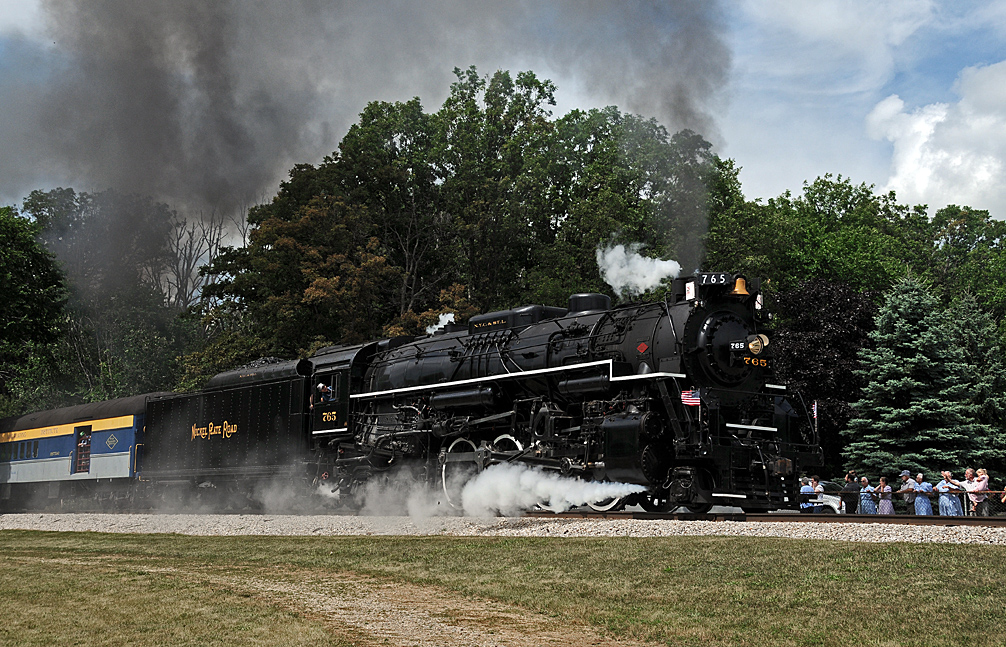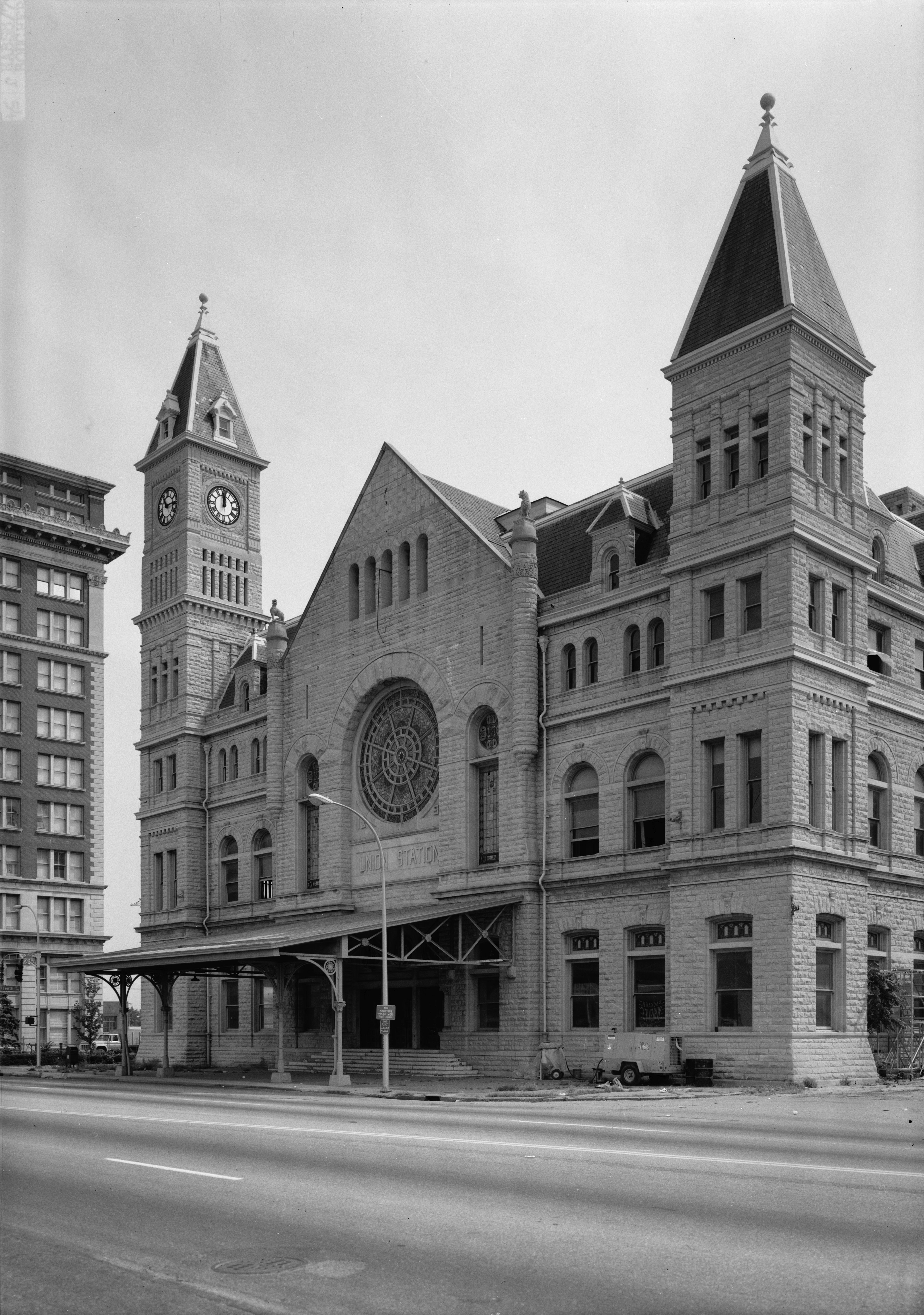|
NKP 779
Nickel Plate Road 779 is a 2-8-4 or "Berkshire" type steam locomotive built for the New York, Chicago and St. Louis Railroad, (reporting mark NKP) completed on May 13th 1949, for use on fast freight trains. It was the last new steam locomotive to be delivered to the Nickel Plate Road, and alongside L&N 1991, another 2-8-4 for the Louisville and Nashville, is the last of 36 steam engines completed by Lima-Hamilton from 1947-1949, and the final 2-8-4 locomotive on standard gauge completed in the world. L-H's first diesel, A-3080 demonstrator #1000 was completed the same day as #779. NKP also received the first production A-3080, NKP #305, one of 4 delivered by Lima-Hamilton in 1949. Upon her retirement in early 1958, the locomotive had logged 677,095 miles. In 1966, she was donated to the City of Lima, Ohio and placed on display in Lincoln Park, where she remains to date. References External linksNickel Plate Roster [...More Info...] [...Related Items...] OR: [Wikipedia] [Google] [Baidu] |
Lima-Hamilton Corporation
Lima Locomotive Works was an American firm that manufactured railroad locomotives from the 1870s through the 1950s. The company took the most distinctive part of its name from its main shop's location in Lima, Ohio. The shops were located between the Erie Railroad main line, the Baltimore & Ohio's Cincinnati-Toledo main line and the Nickel Plate Road main line and shops. The company is best known for producing the Shay geared logging-steam locomotive, developed by Ephraim Shay, and for William E. Woodard's "Super Power" advanced steam locomotive concept – exemplified by the prototype 2-8-4 Berkshire, Lima demonstrator A-1. In World War II the Lima plant produced the M4A1 version of the M4 Sherman tank. History In 1878 James Alley contracted the Lima Machine Works to build a steam locomotive that Ephraim Shay had designed. In April 1880, Lima rebuilt Ephraim Shay's original design, using vertically side-mounted pistons mounted on the right, connected to a drive l ... [...More Info...] [...Related Items...] OR: [Wikipedia] [Google] [Baidu] |
2-8-4
Under the Whyte notation, a 2-8-4 is a steam locomotive that has two unpowered leading wheels, followed by eight coupled and powered driving wheels, and four trailing wheels. This locomotive type is most often referred to as a Berkshire, though the Chesapeake and Ohio Railway used the name Kanawha for their 2-8-4s. In Europe, this wheel arrangement was mostly seen in mainline passenger express locomotives and, in certain countries, in tank locomotives. Overview In the United States of America, the 2-8-4 wheel arrangement was a further development of the enormously successful 2-8-2 Mikado. It resulted from the requirement for a freight locomotive with even greater steam heating capacity. To produce more steam, a solution was to increase the size of the locomotive's firebox, though the 2-8-2 wheel arrangement, with its single axle trailing truck, limited the permissible increased axle loading from a larger firebox. The most practical solution was to add a second trailing axle to s ... [...More Info...] [...Related Items...] OR: [Wikipedia] [Google] [Baidu] |
Coal
Coal is a combustible black or brownish-black sedimentary rock, formed as rock strata called coal seams. Coal is mostly carbon with variable amounts of other elements, chiefly hydrogen, sulfur, oxygen, and nitrogen. Coal is formed when dead plant matter decays into peat and is converted into coal by the heat and pressure of deep burial over millions of years. Vast deposits of coal originate in former wetlands called coal forests that covered much of the Earth's tropical land areas during the late Carboniferous ( Pennsylvanian) and Permian times. Many significant coal deposits are younger than this and originate from the Mesozoic and Cenozoic eras. Coal is used primarily as a fuel. While coal has been known and used for thousands of years, its usage was limited until the Industrial Revolution. With the invention of the steam engine, coal consumption increased. In 2020, coal supplied about a quarter of the world's primary energy and over a third of its electricity. Some iron ... [...More Info...] [...Related Items...] OR: [Wikipedia] [Google] [Baidu] |
Nickel Plate Road
The New York, Chicago and St. Louis Railroad , abbreviated NYC&St.L, was a railroad that operated in the mid-central United States. Commonly referred to as the "Nickel Plate Road", the railroad served parts of the states of New York (state), New York, Pennsylvania, Ohio, Indiana, Illinois, and Missouri. Its primary connections occurred in Buffalo, New York, Buffalo, Chicago, Cincinnati, Cleveland, Indianapolis, St. Louis, Missouri, St. Louis, and Toledo, Ohio, Toledo. The Nickel Plate Road was constructed in 1881 along the South Shore of the Great Lakes to connect Buffalo, New York, Buffalo and Chicago, in competition with the Lake Shore and Michigan Southern Railway. At the end of 1960, NKP operated of road on of track, not including the of Lorain & West Virginia. That year it reported 9.758 billion net ton-miles of revenue freight and 41 million passenger-miles. In 1964, the Nickel Plate Road and several other midwestern carriers were merged into the larger Norfolk and Wes ... [...More Info...] [...Related Items...] OR: [Wikipedia] [Google] [Baidu] |
Lima, Ohio
Lima ( ) is a city in and the county seat of Allen County, Ohio, United States. The municipality is located in northwest Ohio along Interstate 75 in Ohio, Interstate 75 approximately north of Dayton, Ohio, Dayton, southwest of Toledo, Ohio, Toledo, and southeast of Fort Wayne, Indiana. As of the United States Census, 2020, 2020 census, the city had a population of 35,579. It is the principal city of the Lima, Ohio metropolitan statistical area, which is included in the Lima–Van Wert–Wapakoneta, OH, combined statistical area. Lima was founded in 1831. The Lima Army Tank Plant, officially called the Joint Systems Manufacturing Center, built in 1941, is the sole producer of the M1 Abrams. History Lima was named after Lima, Peru's capital city. Shawnee and establishment In the years after the American Revolution, the Shawnee were the most prominent residents of west central Ohio, growing in numbers and permanency after the 1794 Treaty of Greenville. By 1817, the United ... [...More Info...] [...Related Items...] OR: [Wikipedia] [Google] [Baidu] |
Berkshire Locomotive
A "Berkshire" type steam locomotive refers to a steam locomotive built with a 2-8-4 wheel configuration. The design was initially intended to improve on the USRA Mikado design (2-8-2), which was deemed to lack sufficient speed and horsepower. That was overcome by the inclusion of a larger, {{convert, 100, sqft, m2, adj=on firebox, requiring an extra trailing axle, giving the locomotive its distinctive 2-8-4 wheel arrangement. The name of "Berkshire" was chosen for the 2-8-4 type based on the Lima Locomotive Works testing on the Berkshire Hills of the Boston & Albany Railroad. After the Class A-1 successfully outperformed a Class H-10 Mikado, the Boston & Albany Railroad became the first to order the new Berkshires. Over 600 were built by the Lima Locomotive Works, the American Locomotive Company, and Baldwin Locomotive Works. A total of nineteen different railroads purchased Berkshires, including the Erie Railroad, who owned 105 Berkshires, more than any other railroad; the C ... [...More Info...] [...Related Items...] OR: [Wikipedia] [Google] [Baidu] |
Steam Locomotive
A steam locomotive is a locomotive that provides the force to move itself and other vehicles by means of the expansion of steam. It is fuelled by burning combustible material (usually coal, oil or, rarely, wood) to heat water in the locomotive's boiler to the point where it becomes gaseous and its volume increases 1,700 times. Functionally, it is a steam engine on wheels. In most locomotives, the steam is admitted alternately to each end of its cylinders, in which pistons are mechanically connected to the locomotive's main wheels. Fuel and water supplies are usually carried with the locomotive, either on the locomotive itself or in a tender coupled to it. Variations in this general design include electrically-powered boilers, turbines in place of pistons, and using steam generated externally. Steam locomotives were first developed in the United Kingdom during the early 19th century and used for railway transport until the middle of the 20th century. Richard Trevithick ... [...More Info...] [...Related Items...] OR: [Wikipedia] [Google] [Baidu] |
Louisville & Nashville Class M-1
The Louisville and Nashville M-1 was a class of forty-two 2-8-4 steam locomotives built during and after World War II as dual-service locomotives. They were nicknamed "Big Emmas" by crews and were built in three batches between 1942 and 1949. History Construction The first two batches were built by Baldwin Locomotive Works during World War II. The first batch of ten (Nos. 1950–1959) was constructed in 1942. Upon arrival to the L&N, these were initially employed on high-speed freight service. The second batch also consisted of ten members (Nos. 1960–1969). These were built in 1944 and were pressed into passenger service. The third batch consisted of twenty-two locomotives built by Lima in 1949 (Nos. 1970–1991). These were the second to last class of Berkshires to be built and ordered by Lima, the last being the New York, Chicago and St. Louis Railroad S-3 Class, with the last member, No. 779, still around today. The Big Emmas proved to be the most expensive Berkshires built d ... [...More Info...] [...Related Items...] OR: [Wikipedia] [Google] [Baidu] |
Louisville And Nashville Railroad
The Louisville and Nashville Railroad , commonly called the L&N, was a Class I railroad that operated freight and passenger services in the southeast United States. Chartered by the Commonwealth of Kentucky in 1850, the road grew into one of the great success stories of American business. Operating under one name continuously for 132 years, it survived civil war and economic depression and several waves of social and technological change. Under Milton H. Smith, president of the company for 30 years, the L&N grew from a road with less than of track to a system serving fourteen states. As one of the premier Southern railroads, the L&N extended its reach far beyond its namesake cities, stretching to St. Louis, Memphis, Atlanta, and New Orleans. The railroad was economically strong throughout its lifetime, operating freight and passenger trains in a manner that earned it the nickname, "The Old Reliable." Growth of the railroad continued until its purchase and the tumultuous rail ... [...More Info...] [...Related Items...] OR: [Wikipedia] [Google] [Baidu] |
Lima LS-1000
The A-3080 (LS-1000) is a diesel-electric switching locomotive built between May 1949 and April 1950, by the Lima-Hamilton Corporation of Lima, Ohio, United States. The A-3080 is a 1,000 hp (750 kW) switcher, which became the standard for Lima's designs. By changing fuel rack settings, the A-3080 was upgraded to the A-3170, producing 1,200 horsepower (890 kW) from the same turbocharged Hamilton T89SA four-stroke, eight cylinder inline diesel engine, a Westinghouse generator and four Westinghouse traction motors provided the 74,508 lbf (331.43 kN) of tractive effort. Lima-Hamilton never assigned a model number to their models but referred to them by specification numbers. Model designations such as ''LS-1000'' were a railfan invention. Lima-Hamilton assigned A-3080 as the specification number for this particular unit. History In 1946 Lima's Class 1 market prospects were bleak unless it could enter the diesel-electric locomotive field quickly, but they couldn't afford a ful ... [...More Info...] [...Related Items...] OR: [Wikipedia] [Google] [Baidu] |
Nickel Plate Road Locomotives
Nickel is a chemical element with symbol Ni and atomic number 28. It is a silvery-white lustrous metal with a slight golden tinge. Nickel is a hard and ductile transition metal. Pure nickel is chemically reactive but large pieces are slow to react with air under standard conditions because a passivation layer of nickel oxide forms on the surface that prevents further corrosion. Even so, pure native nickel is found in Earth's crust only in tiny amounts, usually in ultramafic rocks, and in the interiors of larger nickel–iron meteorites that were not exposed to oxygen when outside Earth's atmosphere. Meteoric nickel is found in combination with iron, a reflection of the origin of those elements as major end products of supernova nucleosynthesis. An iron–nickel mixture is thought to compose Earth's outer and inner cores. Use of nickel (as natural meteoric nickel–iron alloy) has been traced as far back as 3500 BCE. Nickel was first isolated and classified as an ele ... [...More Info...] [...Related Items...] OR: [Wikipedia] [Google] [Baidu] |






